2014 Cadillac CTS Vs 2015 Hyundai Genesis

Back when record turntables and two-speed automatic transmissions were considered premium, Cadillac ruled the luxury car world.
But a lot has changed since then. Leaded gasoline is gone, tailpipe emissions aren’t as toxic as cooking methamphetamine and the Germans have taken over the luxury car market.
When it comes to mid-size luxury sedans, this is especially true. The Mercedes-Benz E-Class and BMW 5 Series dominate the segment in terms of sales. But Cadillac hasn’t gone away because the all-new 2014 CTS poses a serious threat.
Get the Flash Player to see this player.
Serious About Luxury Cars
Joining Cadillac in the mid-size luxury sedan assault is Hyundai; yes, that Hyundai. When the concept of a large, rear-wheel drive V8 luxury car from Hyundai first surfaced, most people scoffed at the idea. The manufacturer of the Accent subcompact was going to make a luxury car? And badge it as a Hyundai? Yeah right!
But build it they did and the Genesis proved to be a good car. Although it couldn’t quite match the best the segment had to offer, the Genesis was a solid first effort and cost several thousand less than its competitors. Now for 2015 Hyundai has introduced a second generation Genesis sedan that promises to be every bit as good as anything on the market, while still costing a lot less.
V8 vs. Twin-Turbocharged V6
For our test, we grabbed fully loaded, top-of-the-line models from Cadillac and Hyundai. That means the CTS Vsport Premium and Genesis V8 with the Ultimate package. Under hood, the cars have the right specs to compete against the E 550 and the 550i. Instead of using turbocharged V8s like the Germans, Hyundai has a naturally aspirated 5.0-liter V8 while Cadillac opts for a 3.6-liter twin-turbocharged V6. Both cars make 420 HP while Cadillac has a decided torque advantage with 430 lb-ft. compared to the Genesis’s 383 lb-ft.
SEE ALSO: 2015 Hyundai Genesis Review
An eight-speed automatic sending power to the rear wheels is used in both cars, but that is where the similarities stop. Already with a decent torque advantage, the 3,952-lb. CTS also boasts a considerable weight advantage over the 4,541-lb. Genesis sedan. Whereas the Hyundai has decent thrust at all speeds, the CTS is a luxurious rocket. From a dead stop the Cadillac pulls hard, accompanied by a fantastic V6 melody – one of the best sounding six-cylinder engines on sale today.
With excessive weight and a large V8, the Genesis isn’t efficient. Yet, fuel economy ratings of 15 MPG in the city and 23 MPG on the highway, only trail the CTS Vsport by one mile per gallon in both scenarios.
Sports Sedan
The CTS Vsport is more than just an engine. It’s the total package. To reel in all that twin-turbo power, the car is equipped with a set of powerful brakes. Steering is excellent, with a progressive feel that, depending on the drive mode, is appropriately heavy. Body motions are kept in check thanks to GM’s magnetic ride suspension that is far better at transforming the CTS into a sporty ride than the adaptive dampers on the Genesis.
To exploit the magnetic ride suspension, the CTS Vsport features a 50/50 weight distribution and a standard electronic differential in the rear. This all adds up to a well composed, fun to drive car that doesn’t just embarrass the Genesis around corners, but easily rivals the BMW 550i.
Comfort King
But the Genesis isn’t meant to be sporty; it’s the comfort king of the two. If you’re sad at the loss of the Lincoln Town Car, don’t be. The Genesis is your new ride. It has all the comfort of the limo-like Lincoln blended with the sophistication of a Lexus LS. Although it isn’t a corner carving menace like the Cadillac, the Hyundai can hold its own.
The much mocked term road hugging weight comes to mind when driving this car, but it really feels like it’s made out of a slab of granite coated in a protective concrete shell. It’s solid, smooth, comfortable and everything a luxury highway cruiser should be.
Classy vs Modern
The previous generation Genesis looked OK, but was bland and unimaginative. With the second generation, Hyundai has kept it conservative, but far more distinctive. A large front grill and two-tiered LED lighting gives the car more road presence. The rear features attractive LED taillights and quad tailpipes that look to be influenced by Maserati.
As attractive as the new Genesis is, the CTS is stunning. Using hard edges, sharp headlights and low-slung styling elements, it may very well be the best iteration of Cadillac’s Art and Science design theme to date.
Compare Specs
| Vehicle | 2014 Cadillac CTS | Advantage | 2015 Hyundai Genesis |
|---|---|---|---|
| Engine | 3.6 L Twin Turbo V6 | - | 5.0 L V8 |
| Horsepower | 420 HP | - | 420 HP |
| Max. Torque | 430 lb-ft. | CTS | 383 lb-ft. |
| Transmission | 8-speed automatic | - | 8-speed automatic |
| Fuel Economy | 16 MPG city / 24 MPG hwy | CTS | 15 MPG city / 23 MPG hwy |
| Weight | 3,952 lbs. | CTS | 4,541 lbs. |
| Rear Legroom | 35.5-inches | - | 35.0-inches |
| Rear Cargo Capacity | 13.7 cu. Ft. | Genesis | 15.3 cu. Ft. |
| Starting Price | $46,025 | Genesis | $38,950 |
| As Tested Price | $72,640 | Genesis | $55,700 |
Spacious vs. Stylish
The biggest improvements for both cars may be inside because Hyundai and Cadillac both paid attention to the details. While Cadillac went for a more stylish, modern design, Hyundai opted for a more traditional luxury theme. Matte finished wood adorn the dashboard and doors and the leather feels properly premium. We aren’t fans of the grey finishes in the Genesis though and prefer the CTS’s brown leather seating. Although both cars are a comfortable place to be, the Genesis feels more spacious inside partially due to the dual pane glass roof.
SEE ALSO: 2014 Cadillac CTS Review – Video
When it comes to technological wizardry, the cars are pretty even. Both have adaptive cruise control, heated/cooled seats, rear powered sunshade, powered trunks, three-zone climate control and head-up display. The Genesis does trump the CTS by offering an active lane-keep assist, but the CTS has the more sophisticated CUE infotainment system. Each car is stuffed full of safety technology including rear traffic alert and crash detection.
Easy Choice for Rear Seat Passengers
Legroom is said to only be 35 inches in the Genesis, which is tiny. That’s half a foot shorter than a Toyota Corolla and half an inch shorter than the CTS. But in real world testing, the Genesis has all the room in the world compared to the cramped CTS. Six foot tall passengers easy fit in the back of the Hyundai while their heads will be touching the roof of the Cadillac.
The two cars have manual side window shades along with the aforementioned powered rear window shade, but only the Genesis comes with heated rear seats. If luggage is accompanying the passengers, the Genesis can swallow more gear with 15.3 cubic feet of trunk space compared to the CTS at only 13.7 cubic feet.
The Verdict
It’s clear that the CTS and Genesis are targeting different customer bases within the mid-size luxury sedan market. The CTS is after the sporty, “Euro” crowd while the Genesis is targeting the more traditional comfort-orientated luxury car buyer. As improved and competitive as each car is within its sub-segment, one important factor still gives the Genesis a huge advantage; price.
Starting at just $38,950 after destination charges, the Hyundai offers a $7,000 price advantage over the base $46,025 CTS. Step up to our test vehicles and the gap widens as the Genesis V8 with the Ultimate Package comes in at $55,700 compared to the CTS Vsport premium that costs a whopping $72,640. While that is class competitive with BMW and Mercedes, it looks outright expensive compared to the Genesis.
The CTS may be a slightly better car than the Genesis, but it’s in no way $17,000 better. Hyundai continues to play the value game, which is bad news for the competition. The Genesis used to be a good car with a huge price advantage. Now, it’s a great car with a huge price advantage.
2014 Cadillac CTS, 2015 Hyundai Genesis
LOVE IT
- Engine power and sound
- Handling
- Style
- Comfort
- Sophistication
- Price
LEAVE IT
- Price
- Rear seat space
- Fuel economy
- Weight

A 20+ year industry veteran, Mike rejoins the AutoGuide team as the Managing Editor. He started his career at a young age working at dealerships, car rentals, and used car advertisers. He then found his true passion, automotive writing. After contributing to multiple websites for several years, he spent the next six years working at the head office of an automotive OEM, before returning back to the field he loves. He is a member of the Automobile Journalists Association of Canada (AJAC), and Midwest Automotive Media Association (MAMA). He's the recipient of a feature writing of the year award and multiple video of the year awards.
More by Mike Schlee
















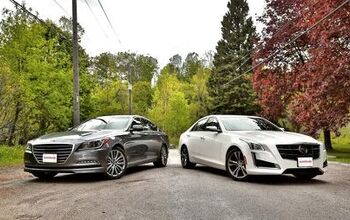
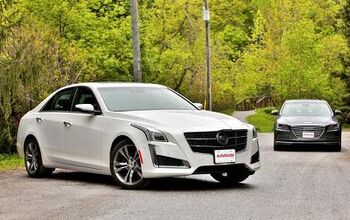

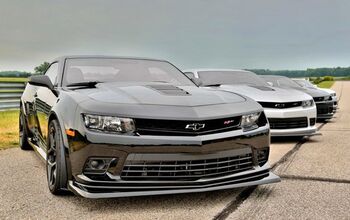

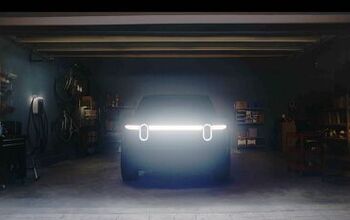

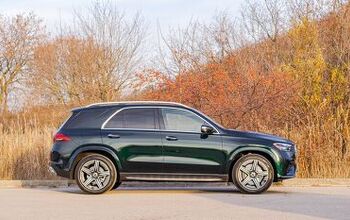

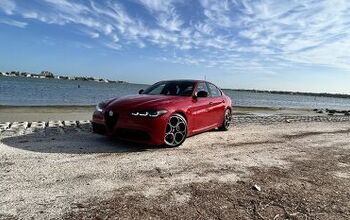





Comments
Join the conversation